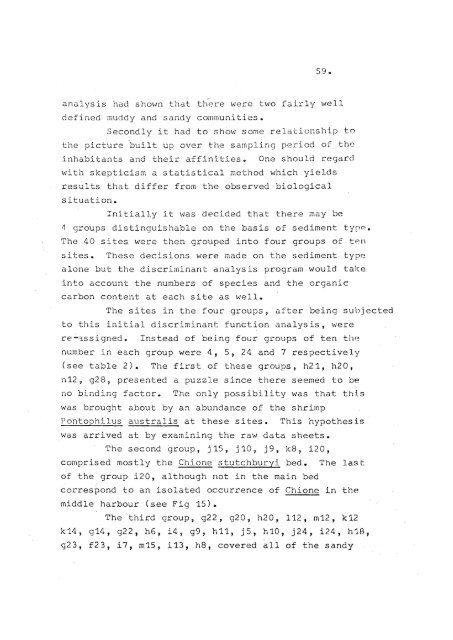The benthic ecology and community structure in Lyttelton Harbour ...
The benthic ecology and community structure in Lyttelton Harbour ...
The benthic ecology and community structure in Lyttelton Harbour ...
Create successful ePaper yourself
Turn your PDF publications into a flip-book with our unique Google optimized e-Paper software.
59.<br />
analysis had shown that there were two fairly well<br />
def~ned<br />
muddy <strong>and</strong> s<strong>and</strong>y communities.<br />
Secondly it had to show some relationship to<br />
the picture ~uilt up over the sampl<strong>in</strong>g period of, the<br />
<strong>in</strong>habitants <strong>and</strong> their aff<strong>in</strong>ities. One should regard<br />
with skepticism a statistical method which yields<br />
results that differ from the observed biological<br />
situation.<br />
Initially it was decided that there may be<br />
4 groups dist<strong>in</strong>guishable on the basis of sediment tYre.<br />
<strong>The</strong> 40 s1 tes, were then grouped <strong>in</strong>to four groups of ten<br />
sites. <strong>The</strong>se decisions were made on the sediment type<br />
alone but the discrim<strong>in</strong>ant analysis program would take<br />
<strong>in</strong>to account the numbers of species <strong>and</strong> the organic<br />
carbon content at each site as well.<br />
<strong>The</strong> sites <strong>in</strong> the four groups, after be<strong>in</strong>g subjected<br />
to this <strong>in</strong>itial discrim<strong>in</strong>ant function analysis, were<br />
re~~ssigned.<br />
Instead of be<strong>in</strong>g four groups of ten the<br />
number <strong>in</strong> each group were 4, 5, 24 <strong>and</strong> 7 respectively<br />
(see table 2). <strong>The</strong> first of these groups, h21, h20,<br />
n12~ g28, presented a puzzle s<strong>in</strong>ce there seemed to be<br />
no b<strong>in</strong>d<strong>in</strong>g factor. <strong>The</strong> only possibility was that this<br />
was brought about by an abundance of the shrimp<br />
Pontophilus australis at these sites. This hypothesis<br />
was arrived at by exam<strong>in</strong><strong>in</strong>g the raw data sheets.<br />
<strong>The</strong> second group, j1S, jl0, j9, k8, i20,<br />
comprised mostly the Chione stutchburyi bed. <strong>The</strong> last<br />
of the'group i20, although not <strong>in</strong> the ma<strong>in</strong> bed<br />
correspond to an isolated occurrence of Chione <strong>in</strong> the<br />
middle harbour (see Fig 15).<br />
<strong>The</strong> third group, g22, 920, h20, 112, m12, k12<br />
k14, g14, g22, h6, 14, g9, hll, j5, hl0, j24, i24, h18,<br />
g23, f23, i7, m1S, i13, h8, covered all of the s<strong>and</strong>y
















